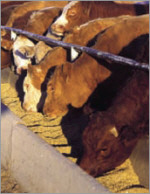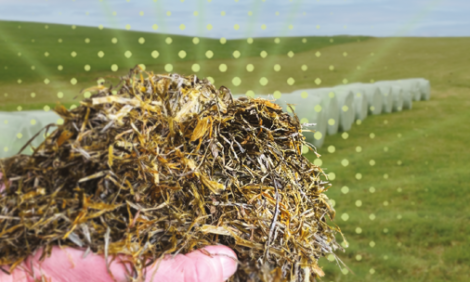



Checklist for Fly Control on Cattle Feedlots
By Alberta Agriculture and Rural Development. Fly control on feedlots is particularly important during the summer months (June through September) when temperatures are warm and fly development is prevalent.
Large fly populations are a concern due to the risk of disease transfer and the generation of nuisance complaints from neighbours. Regular cleaning, monitoring and maintenance of typical fly breeding habitats will help reduce fly populations on feedlots. In general, a clean and tidy operation will have less fly problems than a messy one.

Fly populations are a mix of various lifecycle stages (egg, larva, pupa, adult). Therefore, control methods should be conducted regularly, preferably weekly, to effectively disrupt the fly lifecycle and prevent fly outbreaks. If or when insecticides are used, animals should be removed from the area prior to application and all label instructions strictly followed. Remember, these chemicals will only affect the adult portion of the population and control will only be short-term. Removal of fly breeding habitat is the key to effectively reducing fly populations.
Typically, the main fly breeding area on a feedlot operation is the area under and around feed bunkers where spilled and leftover feed is mixed with moisture and manure. Cleaning up and removing spilled feed on a regular basis and providing concrete aprons around feed bunkers will help prevent the accumulation of suitable breeding habitat for flies. The middle of pens where manure has been compacted by the cattle is relatively fly free, but the outside edges, corners and areas under fencing can all be sources of flies. Runoff areas where water and manure drain into a catch basin are also main sources of fly breeding. Any method taken to encourage rapid drying or clean up of these areas will be beneficial to fly control. It is important to remember to manage other areas around the feedlot yard that may support fly breeding, such as manure piles, silage pits or silos, feed mixers and areas underneath augers where feed has spilled.
Having a written fly management plan and communicating with your neighbours about the actions you are taking to reduce fly populations on your operation will help avoid potential nuisance complaints. Taking a proactive approach to fly control is your best defence.
The following checklist is a tool for you to use in monitoring fly populations and in routine maintenance of key fly breeding habitats on your operation. Please feel free to photocopy and use the checklist as part of your fly management program to:
- identify sites where flies are breeding on your operation,
- locate the potential source of a nuisance fly outbreak, or
- use as a weekly cleanup and maintenance checklist to ensure the effective control of fly populations on your operation.
Remember to keep these checklists as part of your records to confirm the action you have taken to control fly populations on your operation.
For more information regarding fly monitoring and control options, refer to the Alberta Agriculture and Rural Development publication, ‘A Guide for the Control of Flies in Alberta Confined Feeding Operations’.
Fly Monitoring
Potential fly breeding areas: Manure
- moist piles of manure and bedding
- moist areas in pens due to surface water
- areas around and under waterers
- under pen fences and in pen corners
- alley ways and pens of cattle processing areas
Potential fly breeding areas: Feed
- wet spilled feed around and under bunkers
- old feed in bunkers
- silage effluent or spilled silage - front and sides of horizontal silage silos and piles or the base of tower silos
- around and beneath stored hay bales - where hay bales contact the soil
- spilled feed around feed mixing areas and under augers
Potential fly breeding areas: Other
- runoff areas
- areas under tall grass and other vegetation immediately surrounding pens that can become moist areas with degrading plant material
Recommended Control Methods:
- stock pens at high density to compact and trample manure
- remove spilled feed and silage weekly
- enclose or fill in under feed bunkers
- construct concrete aprons around feed bunkers and waterers
- clean sick pens frequently
- scrape and grade pens frequently, filling low areas and contouring for runoff
- cover and store hay bales on dry land or raised pallets, or store hay in properly designed stack yards or hay sheds
- minimize seepage from silage storage by covering and sealing edges of bagged silage and silage piles and cleaning around the base of tower silos
- concrete curbs under pen fences and railings
- raise bottom railings high enough to clean under
- divert surface water by grading and providing drainage around pens and facilities
- keep vegetation around the operation mowed short
Additional Control Options:
- indoor and outdoor fly bait stations
- residual insecticide spray on adjacent vegetation and buildings
- misting for adult fly control as needed*
- treatment withlarvicides†.
* It is important to follow all label directions for product use to ensure personal safety, the safety of others and the safety of livestock.
† Check with your local retailer regarding product options and product registration for use in Canada
July 2008


